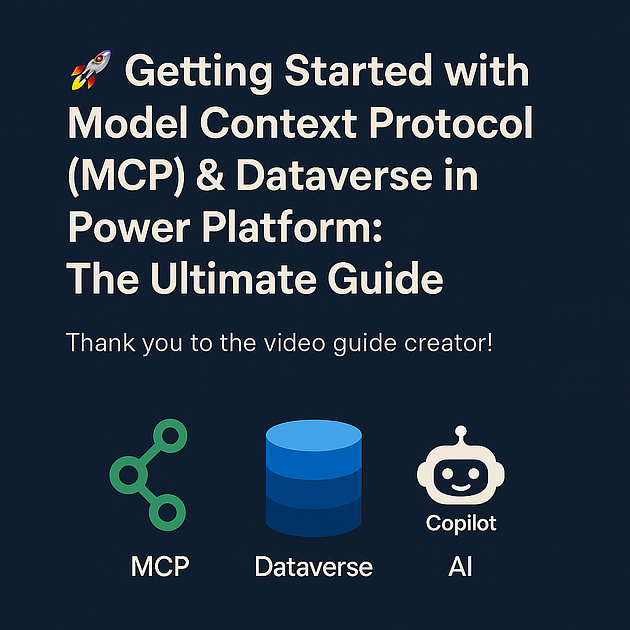
If you’re even a little bit invested in Power Platform, you’ve probably seen the Model Context Protocol (MCP) popping up in community posts, new features, and the Microsoft docs. If you’re wondering, “Is this just another buzzword, or does it actually make my life easier?” — this post is for you!
Let’s break down what MCP is, what you can do with it (hint: a lot!), and why this matters for every maker, developer, and AI enthusiast on the platform.
What is Model Context Protocol (MCP)?
MCP is a new open protocol from Microsoft that lets Large Language Model (LLM) applications — like Copilot Studio, Claude, VS Code Copilot — connect securely and natively to enterprise data sources like Dataverse. This means that your AI agents can “see” and work with your real Dataverse data, safely and efficiently, with no custom connectors or APIs needed.
Learn more: Connect to Dataverse with Model Context Protocol (preview)
Why Does MCP Matter?
- No more manual queries: Just ask questions in natural language — “How many leads are active?” or “Show me a chart of cases by city” — and your agent (Claude, Copilot, etc.) does the heavy lifting.
- Instant insights and updates: You can fetch, update, and create Dataverse records as simply as sending a chat message.
- Build bots and automations faster: Tools like Copilot Studio can now “think” in real time with your data — great for building conversational agents and process automations.
- Less code, more power: You can do all of this without needing to write FetchXML, SQL, or custom code.
- Future-proof integration: Any AI or LLM tool supporting MCP can plug into your Dataverse data — opening up a huge ecosystem of smart, connected tools.
What Can You Actually Do with MCP + Dataverse?
Here’s just a taste of what’s possible right now (and it’s still just in preview!):
- List all your tables: “Show me all tables in Dataverse.”
- Describe schema: “Describe the account table.”
- Read/query data: “How many contacts live in London?”
- Create/update records: “Add a new contact: John Smith, email john@contoso.com.”
- Build charts instantly: “Create a pie chart showing opportunities by owner.”
- Integrate knowledge sources: “What’s the latest update from the product knowledge base?”
Basically, you can talk to your database, and it talks back with real answers, records, or charts — no code, just conversation.
How to Set Up MCP with Dataverse (Step by Step)
This is easier than you think. Here’s the process, based on Microsoft’s official docs :
Prerequisites:
- Dataverse environment (Power Platform, Power Apps, or Power Automate)
- VS Code installed (for advanced setup)
- Claude Desktop (optional, but great as an MCP client)
- .NET SDK 8.0 (for the MCP server local proxy)
- Your Dataverse tenant ID
- Dataverse connection (created in Power Automate)
What Tools Are Available?
From the official documentation, Dataverse MCP tools include:
create_record— Insert a row into a tabledescribe_table— Get table schemaexecute_prompt— Run a predefined promptlist_knowledge_sources— Show available knowledge sourceslist_prompts— List promptslist_tables— List available tablesread_query— Read data from tablesretrieve_knowledge— Query a knowledge sourceupdate_record— Update a record
You can enable/disable each tool in your MCP config, so you’re always in control.
Limitations & Tips
- Preview Feature: As of mid-2025, MCP with Dataverse is still in preview — don’t use in production just yet!
- Security: Make sure you understand the permissions you grant your AI client.
- Customization: Tune which tools you expose, and set your own prompts/knowledge sources for maximum flexibility.
Conclusion
Model Context Protocol (MCP) is the next frontier for Power Platform, AI, and no-code/low-code automation. You can connect any MCP-enabled AI client (Copilot, Claude, custom bots) to Dataverse and get natural, conversational access to your enterprise data.
No more clunky queries. No more endless charts. Just instant answers, insights, and updates — straight from your data, with the power of AI.
A big thank you to the amazing video guide creator
Nathan Rose — your step-by-step walkthrough made the whole process so much more approachable and fun for the community.
No comments:
Post a Comment